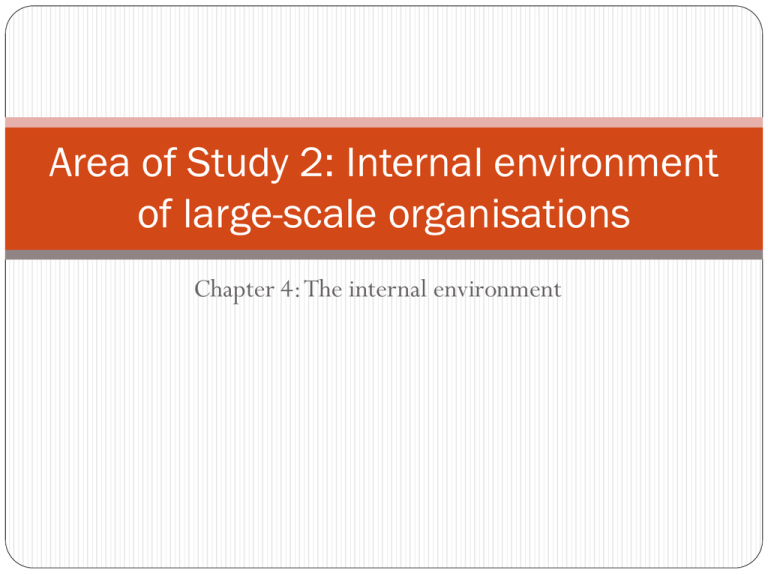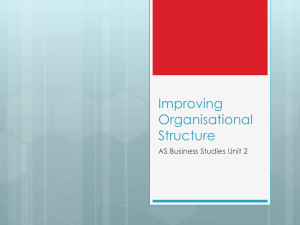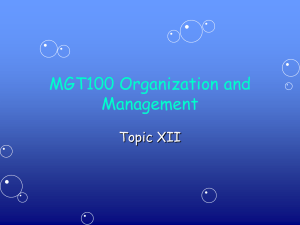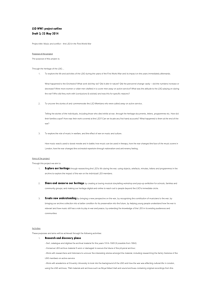Chapter 4 - willihighbusinessmanagementyear12
advertisement

Area of Study 2: Internal environment of large-scale organisations Chapter 4: The internal environment Management Structure Management hierarchy: Senior or executive management: top level, has responsibility for strategic (long-term) planning. 2. Middle management: managers in charge of a designated department or organisational division, have responsibility for tactical decision making 3. Front-line managers: responsible for day-to-day planning and decision making 1. Organisational Structure Structure: way in which the parts of a system or object are organised and coordinated Organisational structure: framework within which the work of that organisation occurs Structures vary between organisations depending on the nature of what they do, their size, numbers of staff and organisational culture Features of Organisational Structure Division of labour Organisational departments or divisions Segmentation and Departments can be based on coordination of activities Traditionally - degree of specialisation, workers becoming experts in a particular activity Changing towards employees being encouraged to become multiskilled to increase worker motivation, productivity and flexibility the following: Function performed: such as marketing, operations, finance, HR Geographic: location of employees, branches Product: product produced by certain groups of employees Customer: type of customer who has special requirements Features of Organisational Structure continued… Chains of command, control and authority Authority: legal and/or moral right to control something or someone Organisational structure identifies who has responsibility for seeing certain tasks are completed Span of control: number of people a manager has direct responsibility for Narrow span of control associated with a more hierarchical structure Communication channels Communication channels in an organisation can be upward, downward or lateral Features of Organisational Structure continued… Patterns of decision making An organisational chart depicts: CEO Lines of authority, span of control Chain of command Reporting relationships Job titles and responsibilities Formal channels of communication Division of labour Levels of management Chief Financial Officer Manager Research and Development Chief Marketing Manager General Manager of Operations Brand Manager Brand Manager Product Manager Product Manager Types of Organisational Structures Hierarchical organisational structure: features centralised decision making (where management make decisions and passes on directions to those below them Bureaucratic structures: “Bureaucracy” means to ‘rule from the desk’. Record keeping, following set rules and due process are at the heart of bureaucracy. Flatter organisational structures: features a wide span of control, few management levels and a short chain of command Forms of hierarchical organisation structures – Functional Structure A form of traditional organisational structure which is based on the functions performed (e.g. finance, marketing) Chief Executive Officer Manager Operations Quality Supervisor Manager Finance Production Supervisor Manager Sales and Marketing Maintenance Supervisor Manager Human Resources Functional Structure Positive aspects Difficulties Specialist in charge of each Structure only works if functional area, expertise ensures high productivity Workers have manager in their area for issues to be resolved Allows for sideways career paths different functional managers communicate with each other Structure best suits medium-to-large organisations Divisional Structure Same foundation as functional structure but each functional area is further divided into subsections Chief Executive Officer Human Resource Manager Training Manager Payroll Manager Operations Manager Recruitment Manager Logistics Manager Production Manager Finance Manager Quality Manager Purchasing Manager Accounts manager Divisional Structure Positive Aspects Difficulties Specialists in charge of A more complicated small sections of the organisation Allows for best practice in areas Room for career advancement within one functional area structure so chances of difficulties in communication become more pronounced Only suitable for quite large organisations Geographic Structure Where the business is conducted in several different locations. Each location would have a functional, divisional or some other type of structure Chief Executive Officer General Manager Australia General Manager USA General Manager Asia General Manager UK Geographic Structure Positive Aspects Allows LSO access to wider markets Local issues/laws can be better handled Employees may have opportunity to work in different countries Allows the implementation of ‘Follow the Sun’ – project passed around the world as each time zone starts its working day Difficulties Different languages can cause communication problems Time can be wasted for senior managers travelling between branches Control can be lost as senior managers can’t be in every location Best suits multinational LSOs Product-based Structure Employees are grouped together according to the product they make or sell Retail company: Chief Executive Officer Manager Human Resources Manager clothing and footwear Manager Operations Manager homewares Manager Sales and Marketing Manager books & stationary Manager Finance Manager Sporting goods Customer-based Structure Departments based on the types of customers dealt with by a group of employees Car Manufacturing Company: Chief Executive Officer Manager Human Resources Manager Operations Manager Sales & Marketing Manager fleet sales Manager Finance Manager retail sales Network/Organic Structure Becoming increasingly common as firms downsize Structure has core business maintained by employees, with non-core functions outsourced to other firms Legal firm HR Consultancy Firm Advertising Agency Core Business Research and Development Firm Manufacturer Accounting Firm Network/Organic Structure Positive Aspects Difficulties Money not wasted on Firms under contract to employing people all year round when only needed occasionally Sometimes using an outside firm will assist in terms of accountability complete work may not have a good understanding of the values and mission of the core business Some control is lost when other businesses are completing work Matrix Structures A structure that places managers and employees into project teams that cut across functional or departmental lines and requires them to report to both functional and task management Senior Management HR Manager Finance Manager Operations Manager Project A HR A Finance A Operations A Project B HR B Finance B Operations B Project C HR C Finance C Operations C Matrix Structures Positive Aspects Disadvantages Control is decentralised, Communication can become better monitoring of all aspects of a job There can be many opportunities for both horizontal and vertical career directions difficult between projects and the head office due to complexity of structure There may be staffing issues when one project finishes if there is not another to begin immediately Would suit LSO that works on several projects at once Consequences of less hierarchical organisational structures Elements of Structure Traditional Hierarchical Structure Contemporary Strucutre Communication Downward Multidirectional Communication Channels Slow and unresponsive to change Shorter communication paths Decision Making Centralised Decentralised Delegation Downward Downwards and Lateral Management style Autocratic Consultative/Participative Layers in structure Multilayered Fewer layers Span of control Narrow Broad Division of labour Specialisation Multiskilled Roles and responsibilities Clear and narrow Greater autonomy Departmentalisation Well defined Cross-departmental teams Outsourcing Limited Non-core functions What is corporate culture? The shared values or beliefs of the people within an organisation, unwritten rules A pattern of basic assumptions shared within an organisation Representative of things that worked well in the past Taught to newcomers as the ‘correct’ way of thinking, feeling and doing Indicators of corporate culture Formal written company policies and objectives Physical environment (including dress code) Organisational structures and management styles Organisational processes Communication channels Rituals, symbols How people address each other Language used Official company documentation Differences in corporate culture Degree to which people are encouraged to become risk takers and innovators Attention to detail People orientation Task or process orientation Team orientation Level of competitiveness Degree of emphasis on ethical and social responsibilities Diversity amongst employees Age of the organisation Causes of change of culture Time New managers – may have a different approach and cause changes Mergers – Two LSOs with different ways of doing things coming together may result in a new culture Macro factors – laws, economic conditions and so on may change culture of an LSO Importance of corporate culture Benefits of a positive corporate culture for an LSO include: Better staff retention rates Increased productivity Greater employee work ethic Greater profitability Positive public perception Google Activity Policy Development and its application A policy is a written statement that outlines processes, procedures, rules and regulations that must be observed in a given situation Sometimes also include procedures: outline steps that should be followed when completing a process Policies are necessary in LSO’s because they: Can help to enforce legal requirements Ensure consistency in approaches to work Can prevent accidents Allow workers to clearly know the boundaries in which they work Pressures on policy development Copy table on page 91 – External and internal pressures on policy External Macro Environment • Legislative Compliance • Social responsibility • Changing markets and international pressures • Technological Developments External Operating Environment Internal Environment • Regulatory bodies • Lobby groups • Trade unions • Customers • Suppliers • Owners/shareholders • Management • Employees Policy development process Step 1: Issue Identification Policy development is a The need for a new policy process of continuous assessment, implementation and reassessment as the company responds to external and internal pressures or the need to change an existing policy Pressure from a source such as a new regulation, manager or social pressure Step 2: Research and analysis Step 3: Stakeholder input Research is conducted into Stakeholders informed of policies of competitors, trading partners and organisations that are known to have ‘best practice’ Assessment of what is needed in the new/updated policy is conducted possible impeding policy change Comment and feedback is collected from interested stakeholders Step 4: Police Development Step 5: Draft policy is posted Draft policy or policy Draft policy displayed in a amendment is prepared by a working party taking stakeholder views and ideas into account public place Stakeholders have opportunity to make comments Comments invited Step 6: Policy approval Step 7: Evaluation Feedback considered Did the policy work? Necessary changes made Was the new policy Appropriate level of management approval obtained Final copy issued Management and employee training on new policy if required effective? Business ethics and socially responsible management of the internal environment Business ethics If way in which people in an organisation conduct their day-to-day work in a morally acceptable way Social responsibility The way in which an organisation demonstrates some commitment to their community beyond that imposed on it by laws E.g. charity work, environmental policies Corporate Social Responsibility Looks at whether companies actually put into practice the values and principles that they espouse Revision Examination Preparation Questions










